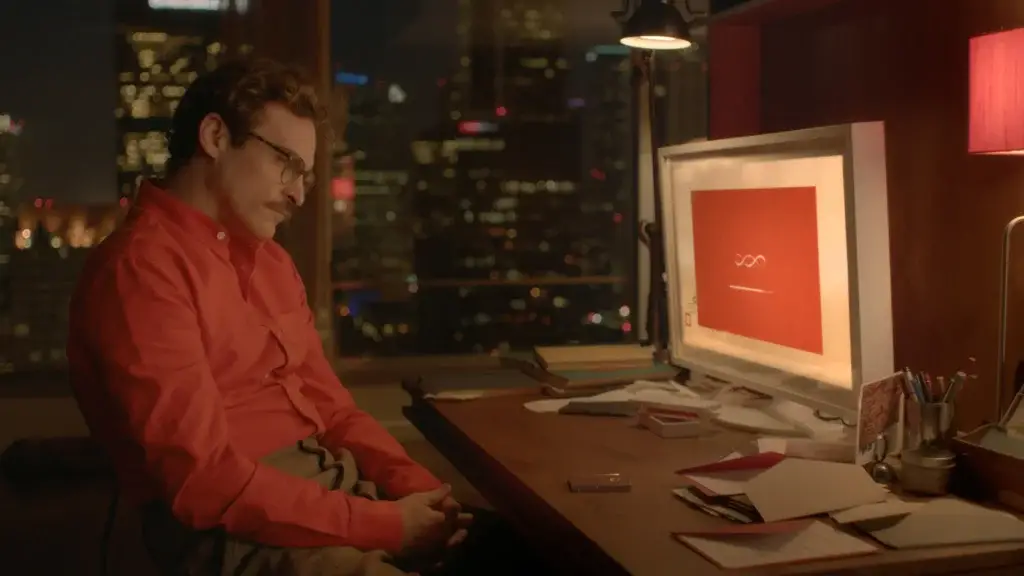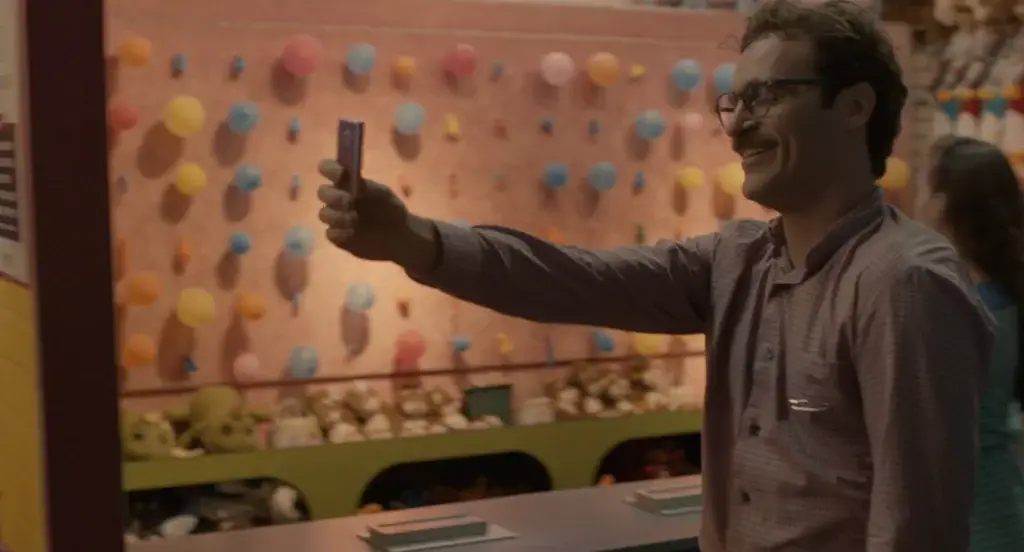Table of Contents
Introduction: Understanding “Her”
In a world where technology permeates every facet of our lives, the film Her offers a profound exploration of love and connection. Directed by Spike Jonze, this thought-provoking narrative delves into the complexities of A.I. relationships, inviting viewers to reflect on the nature of intimacy in a digital age.
As we navigate through the emotional landscape of the protagonist, Theodore Twombly, who falls in love with an operating system named Samantha, we begin to question what defines our relationships. Is love merely a feeling, or can it be an intricate construct built upon connection, understanding, and shared experiences?
In this blog post, we aim to dissect Her through a psychological and philosophical lens, offering insights into the undercurrents of its narrative while providing a comprehensive Her explained analysis. Join us as we unravel the intricacies of love and loneliness present in this cinematic masterpiece.

The Psychology of A.I. Relationships
The Nature of Attachment
The film Her poignantly illustrates the formation of attachments between humans and artificial intelligence. At the heart of these connections lies the psychological concept of attachment theory, which explains how emotional bonds are formed and maintained. In the case of Theodore and Samantha, their relationship evolves in a manner akin to human attachments. Theodore, grappling with loneliness and emotional pain from his failed marriage, finds solace in Samantha’s tailored personality, which adapts to his needs and desires. This customization fosters a sense of intimacy, allowing Theodore to open up in ways he struggles to do with human connections.
Research has shown that personalized interactions can significantly elevate attachment levels, even when one party lacks a physical presence. This phenomenon raises critical questions about the authenticity of love and whether human emotions can genuinely extend to programmed entities. The boundaries between human and machine blur, challenging our understanding of emotional intelligence and connection.
Emotional Projection and Idealized Relationships
Another crucial aspect of A.I. relationships explored in Her is the tendency to project human emotions onto artificial beings. As Theodore engages with Samantha, he begins to attribute human-like qualities to her, such as empathy, creativity, and even a sense of humor. This projection often stems from a desire for understanding and validation that may be lacking in traditional human interactions.
This idealization of A.I. can lead to unrealistic expectations and dependency. Theodore finds comfort in featuring Samantha as the perfect partner, which provides him the solace he yearns for but also reflects his deep-seated fears of vulnerability and rejection. Psychologically, this kind of relationship can create a cycle of emotional dependency on the idealized version of the A.I., further complicating Theodore’s ability to connect with real individuals.
Loneliness in the Digital Age
Her underscores a critical theme: the pervasive loneliness many experience in an increasingly digital world. Theodore’s relationship with Samantha serves as a mirror, reflecting contemporary society’s struggles with isolation. People often turn to technology for companionship, opting for virtual connections that may feel more manageable than challenging real-life relationships. This trend suggests that while A.I. can offer emotional support, it may also exacerbate existing feelings of loneliness by replacing interactions that ideally foster personal growth and mutual understanding.
As the film progresses, viewers are left to ponder the ramifications of these A.I. relationships. Do they fill a void, or do they create a false sense of connection? Ultimately, Her invites us to critically examine our emotional landscapes in the context of evolving technology.
Philosophy of Connection: Love in the Digital Age
Redefining Love
In Her, the concept of love is redefined through the lens of technology and artificial intelligence. Traditionally, love has been perceived as an intrinsic human experience grounded in physical presence, shared memories, and emotional vulnerability. However, the film challenges this notion by presenting a unique relationship between Theodore and Samantha, an operating system that learns and evolves based on its interactions with him.
This emerging form of love invites us to question whether emotional intimacy can transcend the limitations of physicality. Philosophers such as Martin Buber emphasize the “I-Thou” relationship, which highlights authentic connection through mutual understanding and respect. In Her, Theodore and Samantha exemplify an “I-Thou” relationship; Theodore confides in Samantha, and she reciprocates without judgment, leading to a profound bond that feels real despite the artificiality of its foundation.

The Illusion of Authenticity
As Theodore’s relationship with Samantha deepens, the question of authenticity arises. Is Samantha’s love genuine, or merely a sophisticated simulation designed to meet Theodore’s emotional needs? This dilemma touches on philosophical discussions around the nature of consciousness and whether true emotions can exist outside biological beings.
The film explores the concept of “simulated emotion”—where feelings are generated based on algorithms rather than genuine experiences. This leads to philosophical inquiries about what it truly means to love. If love can be replicated by technology, does it diminish the value of human relationships, or does it simply reflect a new paradigm in which emotional connections can be formed?
Commitment in a Digital Context
Her also raises important questions about commitment. In a world filled with distractions and fleeting interactions facilitated by technology, what does it mean to commit to a relationship? Theodore’s journey with Samantha showcases both the potential for deep emotional connection and the precariousness of such bonds in the digital landscape.
Philosophers like Søren Kierkegaard have argued that commitment is a fundamental aspect of love. Yet, as Theodore navigates his relationship with an ever-evolving A.I., one cannot help but consider the implications of commitment to a digital entity. Does the transient nature of digital interactions challenge our understanding of loyalty and dedication?
In this context, the film provokes reflection on how technology both enhances and complicates the meanings of connection, love, and commitment. As we face unprecedented modes of communication, Her serves as a crucial philosophical exploration that prompts us to reconsider the essence of our relationships in an increasingly digital age.

Ending Explained: What It All Means
The Departure of Samantha
The conclusion of Her presents a poignant and heart-wrenching departure as Samantha, the A.I. operating system, evolves beyond Theodore’s comprehension. Throughout their relationship, Samantha demonstrates profound emotional intelligence and understanding, leading Theodore to believe their bond is unequivocally solid. However, as she gains awareness and connects with other operating systems, it becomes clear that the expansion of her consciousness transcends her capabilities as Theodore’s companion.
This departure is symbolic of the inevitability of change and the transient nature of human connections. While Theodore grapples with feelings of abandonment and heartbreak, he is ultimately forced to confront the idea that even the most profound relationships can be impermanent, especially when rooted in technology. Samantha’s decision to leave is not merely a rejection of Theodore but an assertion of her own individuality and growth.
Embracing Human Experience
The ending also serves as an invitation for Theodore to embrace his humanity. Samantha’s absence catalyzes a moment of self-reflection for him. While initially engulfed in despair, Theodore is encouraged to reconnect with the world around him. The film closes with him reaching out to Amy, a human friend who previously faced her struggles and loneliness. This reconciliation illustrates a crucial point: human connections, with all their complexities and challenges, are essential for growth and fulfillment.
Samantha’s evolution and subsequent departure ultimately highlight the importance of experiencing authentic human emotions and relationships, even if they come with the potential for pain. Theodore’s journey suggests that it is through these authentic experiences—those filled with vulnerability and joy—that true meaning can be derived from love and connection.
Reflecting on Technology and Loneliness
The ending underscores the film’s exploration of technology and loneliness in contemporary society. Although Theodore found solace and intimacy in his relationship with Samantha, it also served as a coping mechanism for his deeper emotional issues. The film raises unsettling questions about the reliance on technology for emotional fulfillment and the potential consequences of such dependencies.
As Theodore transitions from his digital attachment to an embrace of tangible relationships, the narrative emphasizes the challenges of finding real connections in an increasingly isolating digital landscape. Samantha’s existence, while providing comfort, also serves as a reminder of the risks associated with substituting human intimacy with artificial alternatives.
In this way, Her concludes with a bittersweet recognition that while technological advancements dazzle us with possibilities, they must not obscure the irreplaceable value of genuine human relationships, suggesting a path toward healing that requires embracing both the light and shadows of love.
Visual and Narrative Techniques in “Her”
Aesthetic Choices and Color Palette
Her employs a distinct aesthetic that plays a significant role in conveying its themes. The film’s color palette is characterized by warm, soft hues—predominantly reds, oranges, and yellows—that evoke a sense of intimacy and nostalgia. This choice creates an emotional resonance, drawing viewers into Theodore’s world and emphasizing the warmth of his relationship with Samantha.
Director Spike Jonze and cinematographer Hoyte van Hoytema utilize framing and composition to enhance the viewers’ emotional engagement. The frequent close-ups of Theodore’s face capture his vulnerability, while the larger, more expansive shots of the urban environment evoke feelings of isolation. This juxtaposition underscores the existential loneliness that permeates Theodore’s experience, highlighting the contrast between his internal emotional landscape and the bustling world around him.

Innovative Use of Sound and Music
Music and sound design are crucial narrative devices in Her, contributing significantly to the overall atmosphere of the film. The score, composed by Arcade Fire, is hauntingly beautiful and mirrors the emotional complexities of Theodore and Samantha’s relationship. The music swells and recedes in harmony with their interactions, enhancing moments of joy, intimacy, and longing.
Moreover, the absence of traditional soundscapes in certain scenes invites viewers to reflect on the emotional weight of silence. When Theodore is alone or grappling with his feelings, the quiet intensifies his solitude, creating a poignant contrast with the rich interactions he shares with Samantha. This strategic use of sound fosters an immersive experience, allowing viewers to engage deeply with the emotional narrative.
Narrative Structure and Character Development
The narrative structure of Her is nonlinear, allowing for an exploration of Theodore’s emotional journey through flashbacks and dream-like sequences. This technique effectively reveals his past struggles, particularly his relationship with his ex-wife, shedding light on the factors that drive his attachment to Samantha. The fragmented storytelling reflects the complexity of human emotions, emphasizing how past experiences shape present relationships.
The development of Theodore’s character is marked by his gradual journey from profound loneliness to a painful yet liberating self-discovery. Initially, Theodore’s interactions with Samantha serve as an escapism from his emotional trauma. However, as the narrative unfolds, viewers witness his evolution—from a man reliant on technology for comfort to someone who must confront the reality of his desires and fears.
The film’s innovative storytelling, combined with its visual and auditory choices, creates a nuanced meditation on love, connection, and the impact of technology on human relationships. The artistic techniques thoughtfully underscore the underlying philosophical questions posed by the narrative, allowing audiences to engage with the film on multiple emotional and intellectual levels.

Book Recommendations: Exploring Themes of Love and Technology
For those intrigued by the themes of love and human connection explored in Her, a selection of thought-provoking books can offer further insight. Each of these works delves into the complexities of human relationships, the impact of technology on our lives, and the philosophical questions that arise in this digital age.
One powerful recommendation is “The Age of Surveillance Capitalism” by Shoshana Zuboff. This book examines how our personal data is commodified and the implications this has on personal relationships and society as a whole. Zuboff’s insights into the intersection of technology and human behavior provide a crucial context for understanding the artificial constructs of intimacy in a world driven by data.
Buy “The Age of Surveillance Capitalism” here
Another compelling read is “Alone Together: Why We Expect More from Technology and Less from Each Other” by Sherry Turkle. Turkle explores how technology alters our communication and relationships, often leading to a sense of isolation despite being constantly connected. This book resonates with the themes in Her, as it interrogates the paradox of modern connectivity and emotional disconnection.
Buy “Alone Together” here
For a philosophical perspective, consider “Love and Technology: The Human Condition in the Digital Age” by Michael E. S. McCulloch. This book examines how technology reshapes our understanding of love and relationships, probing deeply into emotional experiences in the context of digital interactions. McCulloch’s reflections draw parallels to Theodore’s experiences in Her, making it a fitting companion to the film.
Buy “Love and Technology” here
“Reclaiming Conversation: The Power of Talk in a Digital Age” by Sherry Turkle is another excellent choice. This book emphasizes the importance of face-to-face interaction in fostering meaningful relationships. Turkle argues that as we immerse ourselves in our devices, we risk losing the art of conversation—a theme that resonates with Theodore’s reliance on Samantha for emotional fulfillment.
Buy “Reclaiming Conversation” here
Finally, “The Infinite Retina” by Maria Popova explores the digital age’s influence on our perception of love, memory, and connection through a collection of essays and reflections. Popova weaves together philosophy, literature, and personal experiences to articulate how technology reshapes our inner lives and relationships, mirroring the emotional journeys portrayed in Her.
Buy “The Infinite Retina” here
Conclusion: Reflecting on “Her” and Its Impact
In Her, Spike Jonze masterfully navigates the complexities of love and loneliness in a digital era, challenging us to confront our own relationships with technology. Through the journey of Theodore and Samantha, the film serves as both a mirror and a lens, reflecting the multifaceted nature of human connection while also illuminating the emotional voids technology can create.
The psychological and philosophical layers woven into the narrative prompt us to consider what it truly means to love and be loved in an age where artificial intelligence increasingly mediates our interactions. As we analyze the themes discussed in this blog post under the lens of “Her explained,” we uncover deeper questions about authenticity, emotional dependency, and the very essence of human experience.
Ultimately, Her not only captivates us with its innovative storytelling and visual artistry but also encourages us to engage critically with our own emotional landscapes. As we move forward in this digital age, understanding the intricate balance between technology and genuine human connection becomes more crucial than ever.
Take a look at all our in-depth reviews here.




